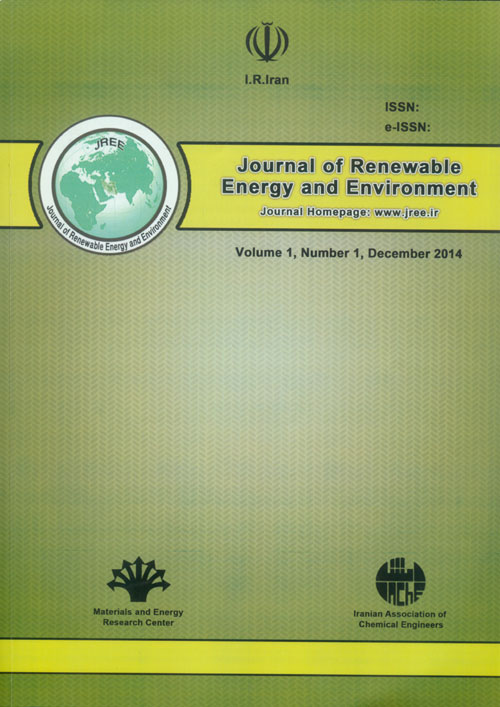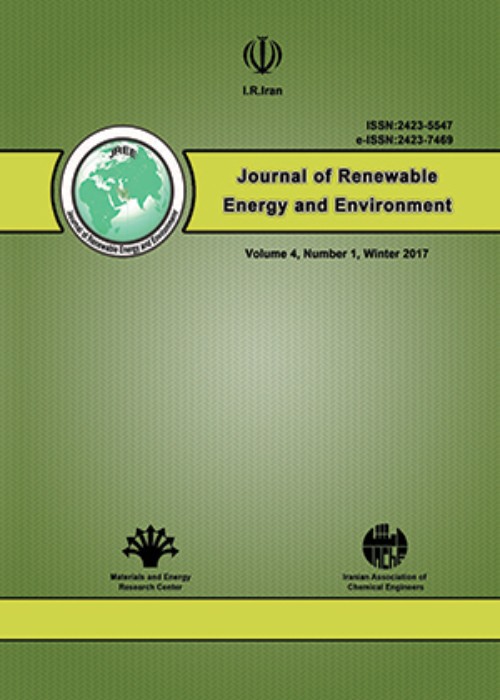فهرست مطالب

Journal of Renewable Energy and Environment
Volume:1 Issue: 1, Autumn 2014
- 80 صفحه،
- تاریخ انتشار: 1394/02/15
- تعداد عناوین: 7
-
-
Pages 1-7A solar still is a viable option when the demand of potable water does not exceed more than 3 litres. Enhancement in distillate output from the solar still is a main goal of many researchers all over the world. In this research, the effect of copper and aluminium plates on distillate output is investigated experimentally as well as theoretically at different water depths under the same climate conditions. In solar stills, first we used solar still augmented with copper plates, second with aluminium and third without any plate called passive solar still. An energy balance equation was applied to solar still for calculation of theoretical distillate output of a solar still with different plates. Three experiments still of 1 m2 in area were constructed from locally available materials. In this work, it was found that the experimental and theoretical results are in good agreement. It was also found that using copper plate in a solar still increases distillate output by 20% (at water depth of 3 cm) and 32% (at water depth of 6 cm) compared with passive solar still, and using an aluminium plate increases distillate output by 10% (at water depth of 3 cm) and 20% (at water depth of 6 cm).Keywords: Solar still, copper plate, aluminium plate, distillate output
-
Pages 8-19Regarding some reported antimicrobial properties of tannins; Zymomonas mobilis was used to obtain ethanol from tannin-reduced carob pod extract (TR-CPE). Culture of 50 mL volume containing 7.5 g sugar at pH 5.5 and 0.03 g bacterial inoculums with shaking at 80 rpm was used. Using response surface methodology (RSM), the maximum ethanol concentration of 5.34 % w/v (higher than that reported earlier, 4.01% w/v) was obtained at the optimized addition levels of yeast extract, peptone, and fermentation time; 0.13 g, 0.62 g, and 43.78 h, respectively. Carob pods extract (CPE) containing 62.23 gl-1 sugar was treated with 3 gl-1 gelatin to decrease its tannin content by 57.87 %. Sugar loss was not observed during gelatin treatment. The results revealed that there was no significant difference in ethanol production, yield, and productivity between TR-CPE and non-TR-CPE. In conclusion, tannin showed no inhibiting effect to maximum ethanol production by Zymomonas mobilis.Keywords: Carob pod extracts, Ethanol production, Tannin, reduced, Zymomonas mobilis
-
Pages 20-29computational fluid dynamics analysis was employed to investigate the species distribution of proton exchange membrane fuel cells (PEMFC) with different channel geometries at high operating current densities. 3D, non-isothermal was used with single straight channel geometry. Our study showed that an elliptical and circular channel cross-section gave higher current density compared with conventional model. However, the elliptical and circular channel configuration facilitated reactant transportation, cause to more homogenous reactants distribution and thus to a lower cathode overpotential of the cell which is the main losses is regard to it. Simulation of the three different channel revealed shoulder width has dominating effect on cells performance and lead to increase the value of Ohmic loss. The numerical model is validated against published experimental data with good agreement. Other result with more detail are discussed and presented in the text.Keywords: channel cross, section, Fuel cell performance, PEM fuel cells, Single, phase
-
Pages 30-42A full three-dimensional, single phase computational fluid dynamics model of a proton exchange membrane fuel cell (PEMFC) with both the gas distribution flow channels and the Membrane Electrode Assembly (MEA) has been developed. A single set of conservation equations which are valid for the flow channels, gas-diffusion electrodes, catalyst layers, and the membrane region are developed and numerically solved using a finite volume based computational fluid dynamics technique. In this research some parameters such as oxygen consumption, water production, temperature distribution, ohmic losses, anode water activity, cathode over potential and the fuel cell performance for straight single cell were investigated in more details. The numerical simulations reveal that these important operating parameters are highly dependent to each other and the fuel cell efficiency is affected by the kind of species distribution. So for especial uses in desirable voltages, for preventing from the unwilling losses, these numerical results can be useful. Finally the numerical results of proposed CFD model have been compared with the published experimental data that represent good agreement.Keywords: PEM fuel cell, Ohmic loss, water activity, CFD, Fuel cell performance
-
Pages 43-52Recently, along with the depletion of fossil fuels and growing electrical requirements, more attention has been paid on utilizing Renewable Energy Sources (RESs). The Chichest tourism complex is located 20 km far from Orumieh, Iran which has been supplied through the main distribution grid connection. But, recently the trend is to expand the share of RESs in supplying microgrids demand. Hence, this study reports the optimum investment planning for electrical expansion of grid-connected Chichest tourism complex including diesel/wind/PV/battery technologies. For the optimal planning of microgrid, an efficient simply-computational two-stage procedure is proposed. In the first stage, all of the feasible system configurations are determined using NREL’s HOMER software which is a well-known and well-established optimal modeling environment. Subsequently, in the second stage based on Analytical Hierarchy Process (AHP) and simple additive weighting (SAW) method, the best configurations for hybrid system are determined through the Expert Choice software considering economical and environmental criteria. With the aim of providing a comprehensive decision-making capability, a sensitivity analysis is performed considering relative importance of criteria. Simulation results demonstrate that for Chichest coast, the best configuration is grid/diesel/wind hybrid system as it shows a uniform behavior for different cases.Keywords: Microgrids, hybrid energy systems, sustainable electricity planning, analytical hierarchy process, sensitivity analysis
-
Pages 53-63Utilization of active and stable catalyst could have enormous advantages in industrial application of biogas reforming. In order to achieve this goal, the effects of Cu and Co as promoters were investigated over physical-chemical properties of Ni/Al2O3-ZrO2 catalyst in reforming of biogas. The sequential impregnation was used for preparation of catalysts. The catalysts were characterized using XRD, FESEM, BET and FTIR analysis. The XRD patterns displayed that the active phases promoters could be effective on nanoparticles dispersion. The FESEM images showed that uniformity of particles size was improved for bimetallic catalysts in comparison with Ni/Al2O3-ZrO2 catalyst but the specific surface areas had no significant change in BET analysis. Higher content of –OH structural groups on surface of Ni-Co/Al2O3-ZrO2 catalyst were proved by FTIR characterization. The performances of catalysts were assessed at atmospheric pressure, feed gas ratio of CO2/CH4= 1, GHSV=24 l/g.h and temperature ranges from 550-850°C. The results revealed Ni-Co/Al2O3-ZrO2 catalysts had the best activity. Because of optimized operating condition and application of ZrO2 as a promoter, the activities of all catalysts remained stable at 850°C for 24 h.Keywords: Dry Reforming, Biogas, Syngas, Promoted Ni, Al2O3, ZrO2, Impregnation
-
Pages 64-70CdSe quantum dots were in situ deposited on various structures of TiO2 photoanode by successive ionic layer adsorption and reaction (SILAR). Various sensitized TiO2 structures were integrated as a photoanode in order to make quantum dot sensitized solar cells. High power conversion efficiency was obtained; 2.89 % (Voc=524 mV, Jsc=9.78 mA/cm2, FF=0.56) for the cells that sensitized by SILAR method. Also all the cells, showed rather high efficiencies (more than 2.65%) regardless of their structure. Here we did the SILAR deposition in room temperature by a simple method which introduces it as a cost effective method for large scale production. Regarding the considerable efficiencies which obtained here by simple SILAR method for various structures, pointed out that SILAR deposition, can be introduced as an effective method for sensitizing electrodes by QDs, in quantum dot sensitized solar cells.Keywords: Solar cell, SILAR, CdSe, Quantum dot


